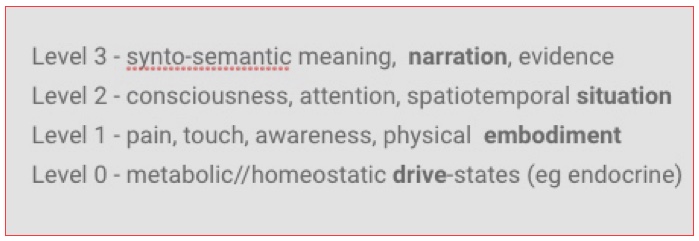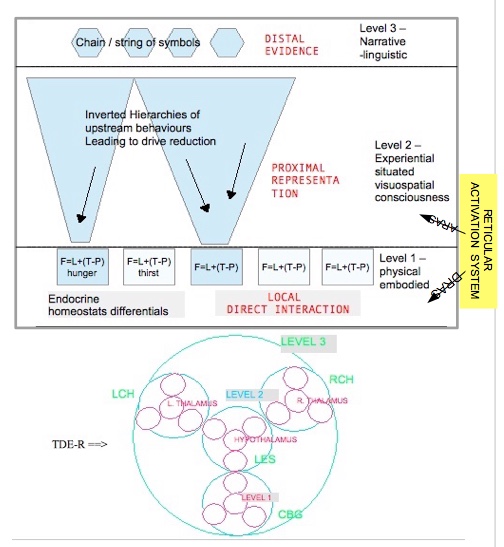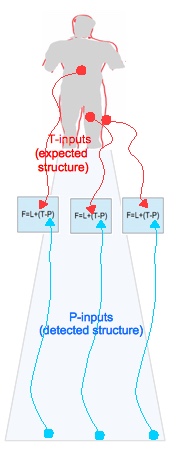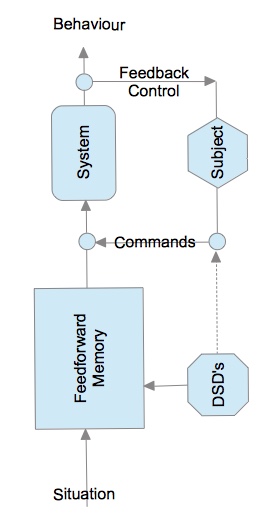Brains of Sand 7 Emotions as Integration (this section under construction)
In this, the final section of the main text body, we combine the concluding summaries from the six previous discussions. By this method, we are finally able to construct a satisfying explanation for biological intelligence, one in which consciousness and emotions are an integral part, not a tacked-on afterthought as is currently the case.
Figure 7.1 - aliases for subjective experience at each level of Marr trilayer

Lambie & Marcel* are keen to distinguish between no less than three distinct emotion categories, a view which is consistent with the upper three levels in Table 10.
The common failure to recognise the aliases is perhaps due to an inherent feature of our phenomenal experience: we try to make it vanish. This behaviour is a direct consequence of the minimax learning rule-
MINImise the MAXimum differential (cyber-affective drive-state)
- Rule 2
While many mental functions decompose readily into a trilayer abstract architecture, consciousness and emotion do not. Instead, they can both be easily associated with any of the three linguistic layers, as in Bernard Barr's Global Workspace Theory (GWT). This concept is depicted in the following diagram.
We are able to construct such a multi level model of the subject by starting at the bottom, representing all the level 0 receptor systems in the body by an array of UnConditioned Stimuli** (UCS's, a.k.a. instincts, genetic programs, unlearned processes such as hunger, thirst, electrolyte and glucose balance, blood pressure, CO2 concentration in blood).
Hughlings Jackson's visionary (1824) recursive model of brain organisation suggests that level (n) items are each made by combining positively and negatively amplified inputs from level (n-1). For example, Level 2 (situated, conscious layer) entities are constructed by combining selections from level 1 (physical, embodied layer). Similarly, Level 3 entities (linguistic, narrative layer) are constructed by combining selections from level 2 (situated, conscious layer).
The result is an inverted pyramid at the bottom (nadir) of which are, inter alia, the level(0) endocrine sensors, modelled as UCS's.
Level(1) sensors and effectors correspond to Conditioned Stimuli (CS*) and Conditioned Responses (CR*). These are related to their Level (0) counterparts by conventional Behaviourist concepts of Classical Conditioning (CC) and Operant Learning (OL). ***
Lambie, J.A. & Marcel, A.J. (2002) Consciousness and the Varieties of Emotion Experience:
A Theoretical Framework. Psychological Review Vol. 109, No. 2, 219-259
** while much of Behaviourism is frowned upon these days, the basic concepts of associative learning ( Conditioned and Unconditioned Stimuli and Responses) and secondary concepts such as Classical Conditioning and Operant Learning, which in turn rely on them, are still assumed to be valid.
*** several alternative terms have gained currency., such as Association Learning for CC, and Reinforcement Learning for OL.

Figure 7.2 - Minimax* drive reduction policy/heuristic in L-lobes selects the best 'upstream' behaviour hierarchies by means of ascending reticular activation system (ARAS).
*minimax is a term in game theory (eg prisoner's dilemma) to describe the policy of
minimizing the maximum cost element (loss)

Figure 7.3
Notes-
(A) Level 3 is the place where sociolinguistic (semantic) goals exist. The language axis (yellow) expresses self-goals, or plans, while the 'emotion' axis (green) represents other-goals'*.
(B) At level 2, goals (Marrian 'computations') are 'compiled' into behaviours**, expressed as spatial position/ velocity trajectory paths. Clearly, other-goals are compiled into other-behaviour paths, by using the 'subjective stance' (modelling others as self). Animals only have two levels, so all their goals are pursued at this level.
(C) At level 1, the behaviours modelled at level 2 are executed in real-time.
(D) When Level (1 )appetites (from plastic interactions between environment and individual) are sated, Level (0) hungers and thirsts are slaked.
*Perhaps this axis involves processing self-goals though the channel intended for other goals, ie as if they belonged to another self.
**"The behaviour of a computational statement is a set of observable actions or changes of status of objects operated by the statement." - On the Informatics Laws and Deductive Semantics of Software (2006) Yingxu Wang. IEEE TRANSACTIONS ON SYSTEMS, MAN, AND CYBERNETICS; VOL. 36, NO. 2
The following discussion concerns Figure 10. We must be careful to distinguish behaviour due to primary DSD's - eg extreme hunger state causing panic eating - and secondary DSD's, which are still DSD's at level 1. These second order DSD's exist within the limbic system, and are a learned response in memory to DSD inputs which would not normally raise awareness within the subject, but because of lessons from past experiences, are viewed as highly predictive of a positive or negative event. Consider driving a car. If the car approaches an intersection, and the driver sees a car begin to edge out into the traffic stream, they instantly steer away from the potential threat and instinctively brake. Yet all that is happening is a small change in the view ahead. This is because their driver training has provided the knowledge that certain small changes in scenario (ie percepts at level 2) are highly predictive of impending danger.
This is consistent with the behaviour model in both GOLEM and TDE theories, where the L-lobe is the source of agency, the locus of all change.
This reasoning suggests a tertiary type of DSD exists in the limbic system, one that refers not to conscious percepts at level 2 (as in the car example) but semantic concepts at level 3, eg inflammatory political rhetoric heard on the radio, seen on TV or read about in print. If we read something upsetting, this can cause the creation of a tertiary DSD in the limbic lobe. This is a valid DSD, nevertheless, because it is one that produces motivated behaviour (eg writing a protest letter to the publication/media outlet about the offensive article).
The rationale behind secondary and tertiary DSD's is as follows- there must be some common mode of comparison, some mechanism for ranking primary, secondary and tertiary DSD's as to their common importance.
The problem is, importance itself is a 'movable feast'. We humans can and do construct goals at various time scales and information 'compartments'. Importance criteria can be used to rank relative drive magnitudes at INTERsubjective level (ie societal criteria, making memory reference to general/ semantic knowledge - RCH*), INTRAsubjective level (ie personal/ situational preference making memory reference to episodic/ autobiographical knowledge - LCH*) or INFRAsubjective level (visceral/ somatic/ embodied reaction, either aversive or appetitive, making reference to classical/ operant conditioning - CBG*).
The relative magnitude of goals sufficient to decide to initiate action (behaviour) is less than the magnitude needed to think about acting in a certain way. In the former case, any thought involves only the planning necessary to successfully complete a behaviour, in the latter case, the precursor ideation to more than one courses of action (or to act, or not to act) are seriously considered. In most cases, the penalty for acting wrongly or against one's will exceeds the cost of thinking about acting, but this is not always true. Sometimes the best strategy is to act without considering all the various options, since thinking through the alternatives may well cause levels of anxiety sufficient to lead to future immobility when faced with similar circumstances.
*Endel Tulving confirmed TDE-R theory with his classification of memory types according to CNS location. LCH = left cerebral hemisphere; RCH = right cerebral hemisphere; CBG = cerebellum & basal ganglia.
Thomas Metzinger identifies two parts of consciousness, an omnipresent 3D immersive phenomenal component, and a transient intentional focussed component. In the TDE/GOLEM model, subjective experience consists of a thresholded sensory binary dimension (Conscious and Unconscious), and a thresholded motor binary dimension (Voluntary and Involuntary).
*Metzinger, T.H. (1997) Denotational Semantics
...

PAIN - a cybernetic phenomenon
Normal situation is that T-P is almost zero, except when injury or overload occurs, and P-input is reduced or absent. This input type is felt as localised pain signals at TDE level 1. Clearly amputation represents a case where P values are literally undefined. Some amputees suffer no phantom pain, while others do. Use of a mirror allows level 2 limbic percepts (ie consciousness) to 'fool' the somatic model builder, and thus 'forcibly* correct' the T values, and reduce the painful difference -L**= T-P***. Alternatively, the -L value (pain at level 1 is an emotion, theoretically speaking) can be balanced by F, a signal which results from an involuntary movement. All pain is referred- by definition, pain is experienced at locations removed from the location of the cause, or original insult. Pain is ALWAYS felt within the L-lobes. These are located at the sensorimotor periphery for level 1 TDE's (remember, there are 16 of them).
Unfortunate people with thalamic tumours suffer intense chronic pain because a subset of their P-inputs are permanently blocked. They are generally worse off even than amputees with phantom limb syndrome.
*in general, level(n) entities can over-ride those at level(n-1). This is a natural result of Jacksons system building paradigm- selectively adjusted superveilance.
**note that -L (the negative of the top-down command input) is interpreted as pain. If we interpret command input L as increasing order (predictability), then -L is decreasing order, making the system less predictable. This reduction in order at level 1 is, according to the psycho-physics equation (PPE), equivalent to pain. How interesting! Also seems to lend support to the PPE!
***the brain is fractal- EVERY sub-system, as well as the assembly of ALL the sub-systems, sub-sub-systems and so forth, follow the same neural signalling rule - F = L+(T-P). The simplest case, the biceps and elbow mechanism, is the easiest example to start with. Both Dyer & Feldman use this simple example to demonstrate that efference copy is an incorrect theory.

Thus, DSD's are compared on the basis of their Common Relative Importance (CRI), which allows memories at three Tulving/TDE-R levels to contextually mediate raw DSD inputs. Memories act as a context with which to interpret drive-state differentials. Cybernetically, this means the memory context is a feedforward axiomaton (axioms are theoretical assumptions) .
(see also www.biointelligence2.webnode.com )
This combination of feedforward context plus feedback affective content is called the UGP or Universal Governance Paradigm. All complex machines can be viewed as UGP's, that is, a feedforward mathematical structure in combination with a feedback cybernetic process loop. The UGP reminds us that mathematics is not a universal model. There are some systems that mathematical (feedforward pre-computed) formulae cannot model. The brain's motor production system (ie all voluntary movement) is the most important example of this type. Only Dyer and Feldman (in the recent period) discovered the correct solution to top-down sensorimotor muscle-limb control. Positions are set according to global goals, transparently, in an open loop manner, while forces are computed automatically, and opaquely by local feedback.
Computer science uses the UGP paradigm to load and use firmware, or ROM's, without acknowledging or even knowing it. The firmware code is downloaded onto the target microprocessor (eg an ASIC), where it receives command inputs from, and provides response outputs to, the super-veiling software code (which has already been compiled into an executable image)
